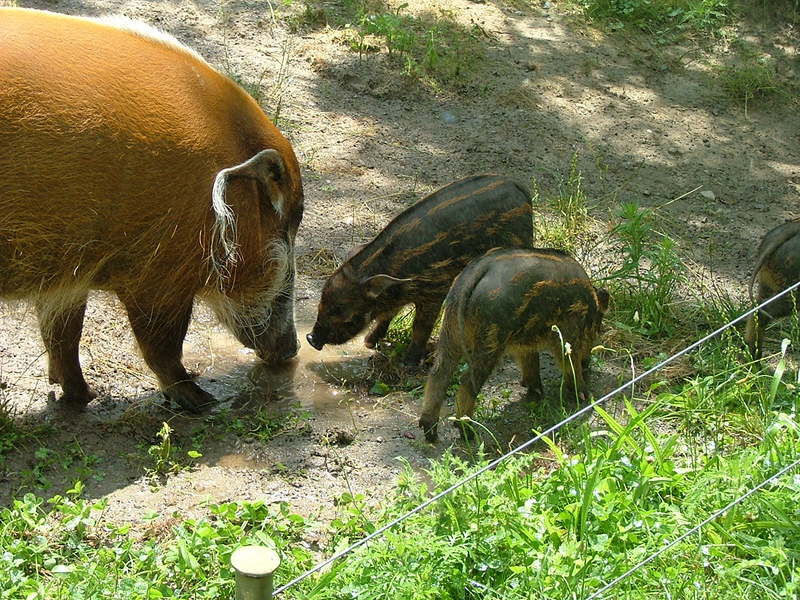|
| Query: Leopard | Result: 1389th of 1434 | |
Red River Hog (Potamochoerus porcus) - Wiki
| Subject: | Red River Hog (Potamochoerus porcus) - Wiki
| |

| Resolution: 1600x1200
File Size: 655867 Bytes
Date: 2003:01:01 00:37:40
Camera: FinePix S5000 (FUJIFILM)
F number: f/4.4
Exposure: 10/4000 sec
Focal Length: 1540/100
Upload Date: 2007:09:16 17:21:09
|
ERROR : Server Busy(-1105)
ERROR : Server Busy(-1105)
Red River Hog (Potamochoerus porcus) - Wiki
Red River Hog
From Wikipedia, the free encyclopedia
[Photo] Red River Hog and piglets at the Toronto Zoo. Taken by Mike Dewar, July 2006.
The Red River Hog (Potamochoerus porcus) also known as Bush Pig (but not to be confused with the Bushpig), is a wild member of the pig family that lives in the rainforests, mountains and brushes of Africa.
Adults weigh up to 200 lb and stand 0.6-0.75 m. The fur is brown, with black legs and black and white snout along the top, a white stripe goes end to end on the spine. They live in herds of 6-20 members, led by the strongest boar. Typically, 3-6 piglets are born at a time.
Red River Hogs eat grass, berries, roots, insects, mollusca, little vertebrates and carrion. They are capable of causing damage to plantations.
Description
The Red River Hog has a striking red fur. There is a vague, white line thats runs over the back. The animal has a blank face mask around the eyes, on the cheeks and on the jaws. The muzzle and the face are black. The hair on the jaw and the flanks is longer than on the rest of the fur.
The Red River Hog has length of 1 to 1.5 meter. The thin tail is 30 to 45 centimetres long. The boar is somewhat larger than the sow. Also, the male has recognizable humps/lumps on both sides of the muzzle and rather small, sharp battle cogs.
Behaviour
The Red River Hog is omnivorous. It eats mainly roots and turnips, and completes its diet with fruit, grasses, herbs and animal food such as eggs, dead animal and plant remains, insects, and lizards. To find the turnips, roots and insects, it tosses its large muzzle in the ground. In this way, Red River Hogs can cause much damage to agricultural plants.
The Red River Hog is mostly nocturnal. By day, they hide in dense bushes. After sunset, they roam around in troops, in search for food. The Red River Hog is a good swimmer but is unable to hold its breath for long.
They live in small troops of four up to twenty animals, comprising a male (boar), some adult sows and their piglets. The boar defends its harem aggressively against carnivores; the leopard is its most important enemy. Different troops merge sometimes and form groups of up to sixty animals.
Distribution and habitat
The Red River Hog lives in rainforests, wet, dense savannas, in forested valleys, and in the nearness of rivers, lakes and marshes. The distribution ranges from the Congo area, from Gambia to East-Congo, southwards to the Congo River and the Kasai. They can also be found on the island of Madagascar.
http://en.wikipedia.org/wiki/Red_River_Hog
| The text in this page is based on the copyrighted Wikipedia article shown in above URL. It is used under the GNU Free Documentation License. You may redistribute it, verbatim or modified, providing that you comply with the terms of the GFDL. |
|
Comments |
|---|
| | Guest |
|
Potamochoerus porcus
red river hog
West and Central Sub-Saharan Africa to Northern South Africa and Madagascar. |
^o^
Animal Pictures Archive for smart phones
^o^
|
|
|

